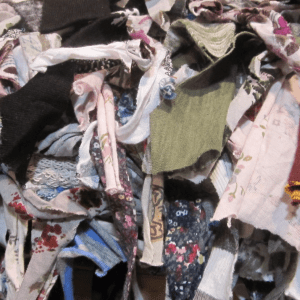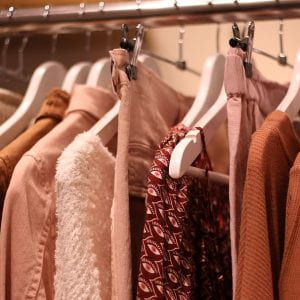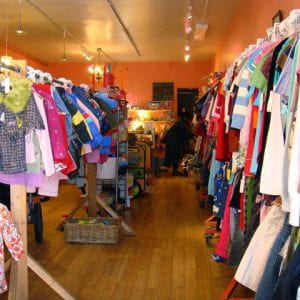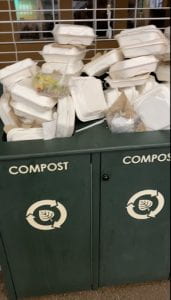Slow Fashion: Creating a Sustainable Closet Amidst the Fast Fashion Landscape
Fast fashion, a popularized term commonly referred to as cheap clothing items that are rapidly mass-produced alongside changing style trends. The current use of this term has shifted amidst the Digital Age, where purchasing has become as easy as the click of a button. Boosted by social media outreach, fast fashion retailers swiftly approach their Gen Z audience via colorful ad posts and brand deals where (micro)celebrities often feature their apparel. Despite the consumer benefit of feeling fashionable at an affordable price, environmental resources used by garment manufacturing companies pay the price that consumers don’t see.
Fashion: Where It Began, and Why We Want It
What’s the difference between clothes and fashion? Most of us associate fashion with style, runways, and luxury, whereas clothes are just materials needed to cover our bodies in a more practical sense. While the term fashion didn’t come about until the 1300s, clothing design is an integral part of cultural customs and environmental adaptations. This is exemplified by Ancient Rome and Ancient Egypt as each culture turned clothing into a status symbol. Wealthy leaders wore bright clothing dyed with rare plant extracts, compared to poor citizens who wore neutral-toned garments that suited work comfortability (Reese, 2022). The distinction between classes isn’t made clear by only the palette of their outfits, but by the hands that made them as well. Oftentimes, the working class needed to hand-sew their own clothes with scrap resources while wealthy folk had the means to purchase rare materials and finished products from laborers. Similarly, modern fast fashion removes consumers from the creation process, relying on cheap labor for cheap goods, oftentimes overseas–out of sight, out of mind.
Fashion became a cycle, which would gradually pick up speed as time progressed, during the Industrial Revolution. Factories rapidly arose in the 1800s, and clothing wasn’t excluded from the methodology of mass production. Individual garments were produced faster for cheaper labor as automatic machine weaving allowed technology to replace time. As machine-made clothing became more accessible, appreciation of hand-crafted work increased, marking the beginning of Haute Couture. Maintaining the artistry of clothing design, Haute Couture founder Charles Fedrick Worth created custom-made garments for wealthy clients in the form of “seasonal drops,” the starting point for circulatory fashion.
With factory-produced clothes becoming cheaper and handcrafted fashion becoming more expensive, how did the words ‘fast’ and ‘fashion’ collide? The term “fast fashion” first appeared in the U.S. during the 1990s in The New York Times, detailing the first Zara shop to open in New York City and Zara’s mission to bring designs to clothing racks within a 15-day period (Lai, 2021). Increased technologies such as the airplane made it more accessible to import cheaper materials from other countries, while patterns of fashion designs became easier to forge from magazines and television (even faster today through the internet and social media). These combined efforts allow companies to pride themselves upon trendiness, the ability to keep up with newfound popularity within a short period, oftentimes relying on celebrity output. The cultural pattern of placing the wealthy as fashion spearheads continues, except today we look toward the entertainment industry rather than our political leaders. As we find comfort in sharing styles with our favorite idols, we feel as though we have the potential to achieve the same status or costume ourselves with similar attitudes. It also allows us to connect with others who share the same interests, identifying shared tastes based on a single outfit. Plus, who can pass up an $8 shirt?
Behind the Screens: Environmental Impacts
1. Rack to Landfill Pipeline
 Clothing products took 15 days to go from designer to retailer in the 90s. Imagine how quickly it takes for products to make it to the e-commerce world today! As a result, 100 billion tons of textiles are produced each year, and 92 million tons of those textiles end up in landfills. (Igini, 2022) From observation and experience, consumers are less likely to keep fast fashion items due to their unflattering fit, resulting from the rushed production and cheap materials. Additionally, the temptation to continue buying new designs for cheap prices becomes harder to avoid, especially in a decade where young people want to look ‘picture-perfect’ when sharing media online.
Clothing products took 15 days to go from designer to retailer in the 90s. Imagine how quickly it takes for products to make it to the e-commerce world today! As a result, 100 billion tons of textiles are produced each year, and 92 million tons of those textiles end up in landfills. (Igini, 2022) From observation and experience, consumers are less likely to keep fast fashion items due to their unflattering fit, resulting from the rushed production and cheap materials. Additionally, the temptation to continue buying new designs for cheap prices becomes harder to avoid, especially in a decade where young people want to look ‘picture-perfect’ when sharing media online.
2. Carbon Emissions – Global Transportation and Synthetic Fibers
The fast fashion industry is also one of the leading causes of global warming, causing greater emissions than the airline industry and falling just behind the oil and gas industry. Daunting statistics on the opposite end of mass-produced prices indicate “apparel and footwear industries together accounted for more than 8 percent of global climate impacts–the equivalent of 3,990 million metric tons of carbon dioxide in 2016…Total greenhouse gas emissions related to textiles production are equal to 1.2 billion tons annually.” (Cerullo, 2019) With online merchandise growing in popularity, the only option for delivery would be through airplanes or ships, each causing a substantial amount of pollution. Fashion factories also contribute to the depreciated air quality in the countries they are in, predominantly China, Vietnam, and Bangladesh.
3. Water Waste and Toxic Chemicals
Machinery and technology are not the only pitfalls of the fast fashion production process. Natural resources are also at stake, as curated chemicals are the leading assistant to manufacturing speed. Rather than utilizing raw materials, which requires patience for the cotton plants’ lifecycle, modern consumer demand results in most garments being made up of synthetic fibers. Utilizing 200 tons of fresh water and 8,000 synthetic chemicals yields only one ton of dyed synthetic fabric. Water waste from this process is immediately discarded into rivers and waterways, damaging the drinking-water quality in production countries and negatively affecting their agricultural systems. The effects of tainted natural resources will cause lasting damage to their environment.
Slow Fashion: Creating an Eco-Friendly Clothing Rack
1. Sustainability begins with Sustain
 Take a look at your current closet. Do you think your parents had the same variety when they were your age? How about your grandparents? Of course, there are many socio-cultural differences between each generation, but it’s important to reflect upon why we tend to buy and throw-away clothes at a significantly higher rate: technological convenience. One of the best ways to reduce your carbon footprint is to increase the longevity of your current apparel. Remind yourself that it’s okay to repeat outfits! If an outfit makes you look good and feel good, allow such sentiments to last. Look into the depths of your closet and wear a garment that you have only worn once or twice, maybe you have forgotten about its existence altogether. If you are looking to shop, choose items that you can wear multiple times and that will last several years. When an item doesn’t fit or becomes distasteful, avoid the landfill by upcycling the item for further use, trade clothes with family or friends, or donate to a local thrift store.
Take a look at your current closet. Do you think your parents had the same variety when they were your age? How about your grandparents? Of course, there are many socio-cultural differences between each generation, but it’s important to reflect upon why we tend to buy and throw-away clothes at a significantly higher rate: technological convenience. One of the best ways to reduce your carbon footprint is to increase the longevity of your current apparel. Remind yourself that it’s okay to repeat outfits! If an outfit makes you look good and feel good, allow such sentiments to last. Look into the depths of your closet and wear a garment that you have only worn once or twice, maybe you have forgotten about its existence altogether. If you are looking to shop, choose items that you can wear multiple times and that will last several years. When an item doesn’t fit or becomes distasteful, avoid the landfill by upcycling the item for further use, trade clothes with family or friends, or donate to a local thrift store.
2. Looking for Cheap? Try Off-Price Retailers
Low prices are the most convenient factor of fast fashion, yet off-price outlets provide the same convenience while diverting clothes from going directly from corporate retailers to landfills. The most popular off-price retailers in America include TJ Maxx, Marshalls, Ross, Burlington, and Nordstrom Rack, each providing an abundant selection of ready-to-wear garments that are presumably never worn or owned prior. Oftentimes the selection of merchandise within stores includes popular brands such as Nike, Tommy Hilfiger, Two-Faced, and more! Ross’s official website reported a 67% landfill diversion rate, detailing the ways that such companies focus on sustainable energy emissions, waste management, and sustainability within their supply chain.
3. Vintage, Consignments, & Thrift Stores
 Fashion and trendiness also pride themselves on being difficult to obtain, which oftentimes translates to monetary expense. However, I believe that time is the most valuable resource when making fashionable yet sustainable and ethical shopping decisions. Another suggestion for “trendy” clothes while increasing a garment’s lifespan would be at vintage, consignment, or thrift stores. Every trend since the 1960s mimics similar garment patterns from preceding decades as time moves forward, therefore ‘outdated’ clothes sold secondhand are likely comparable to modern trends that ultimately reappear in variations. Vintage stores being the most “fashionable,” their products are the most expensive of the three options. Their racks contain items that are usually over 20 years old, in near-pristine condition and were produced by luxury retailers. When an article of clothing is rare, the price will match its value.
Fashion and trendiness also pride themselves on being difficult to obtain, which oftentimes translates to monetary expense. However, I believe that time is the most valuable resource when making fashionable yet sustainable and ethical shopping decisions. Another suggestion for “trendy” clothes while increasing a garment’s lifespan would be at vintage, consignment, or thrift stores. Every trend since the 1960s mimics similar garment patterns from preceding decades as time moves forward, therefore ‘outdated’ clothes sold secondhand are likely comparable to modern trends that ultimately reappear in variations. Vintage stores being the most “fashionable,” their products are the most expensive of the three options. Their racks contain items that are usually over 20 years old, in near-pristine condition and were produced by luxury retailers. When an article of clothing is rare, the price will match its value.
One price tier below vintage would be consignment stores. Their product range is more exclusive than thrift stores as they select what they deem fit for resale, paying their donors for contributions. This option features the two main appeals of corporate fashion retailers: style and price. The downside is the fact that the merchandise was previously owned, allowing subjectivity to slight damage. However, with garment longevity being pushed further away from prioritization, the argument against barely-noticed tarnishes is weakened in terms of valuing the item as a whole.
Finally, as many Gen Z members know, thrifting has become the dominant trend in environmental combat against fast fashion. Thrift stores are also a viable option in terms of finding valuable clothes at comparative prices to fast fashion retailers, yet the supply is significantly ample and diverse. Longer and more inspective browsing time is required to replace monetarily ready options from corporations. Yet, that’s the fun of the process! Looking through endless isles for valuable items makes the bargain worthwhile, almost as if they are diamonds in the rough. The convenience of corporate retail dominates the deliberate process of shopping in thrift stores, as brands utilize the same stylists for providing the template of consumer popularity. Yet, the individualized tastes of consumers also contribute to one’s fashion sense. Thrift stores fulfill this desire by hosting a plethora of options to align with differing styles. The mission of thrift stores is to give back to the community, aiding underprivileged groups with their funds raised, and the clothes themselves are often the only resource for families unable to afford retail merchandise. For privileged thrift store consumers, it’s easy to fall into the gratification of purchasing valuable discounted items—leading to the fast fashion consumption habit of buying in bulk and then not keeping or maintaining cheap purchases. Overconsumption by these shoppers drives up the price alongside increased demand, contradicting the thrift store’s purpose. Therefore I urge you to donate back as much as you take, helping thrift stores maintain price stability and keeping your closet from overflowing. Happy thrifting!
Works Cited
Cerullo, Megan. “Fashion Industry’s Carbon Impact Bigger than Airline Industry’s”. CBS News, CBS Interactive, 19 Apr. 2019, https://www.cbsnews.com/news/earth-day-2019-fashion-industrys-carbon-impact-is-bigger-than-airline-industrys/.
Igini, Martina. “10 Stunning Fast Fashion Waste Statistics.” Earth.Org, Earth.Org, 2 Aug. 2022, https://earth.org/statistics-about-fast-fashion-waste/.
Nabeerasool, Akmez. “How Is Fast Fashion Polluting Our Water?” Open Access Government, Open Access Government, 14 Nov. 2019, https://www.openaccessgovernment.org/how-is-fast-fashion-polluting-our-water/77704/.
Reese, Particia. “Fashion History, Evolution, & Timeline.” Study.com, 16 Apr. 2022, https://study.com/academy/lesson/the-history-of-fashion-trends-design.html.
Vilaça, Julia. “How the Industrial Revolution Changed Fashion.” Fashinnovation, 12 Apr. 2022, https://fashinnovation.nyc/industrial-revolution-and-fashion/.
“Waste Management and Recycling.” Ross Stores, Inc., https://corp.rossstores.com/responsibility/operating-sustainably/waste-management-and-recycling/.


